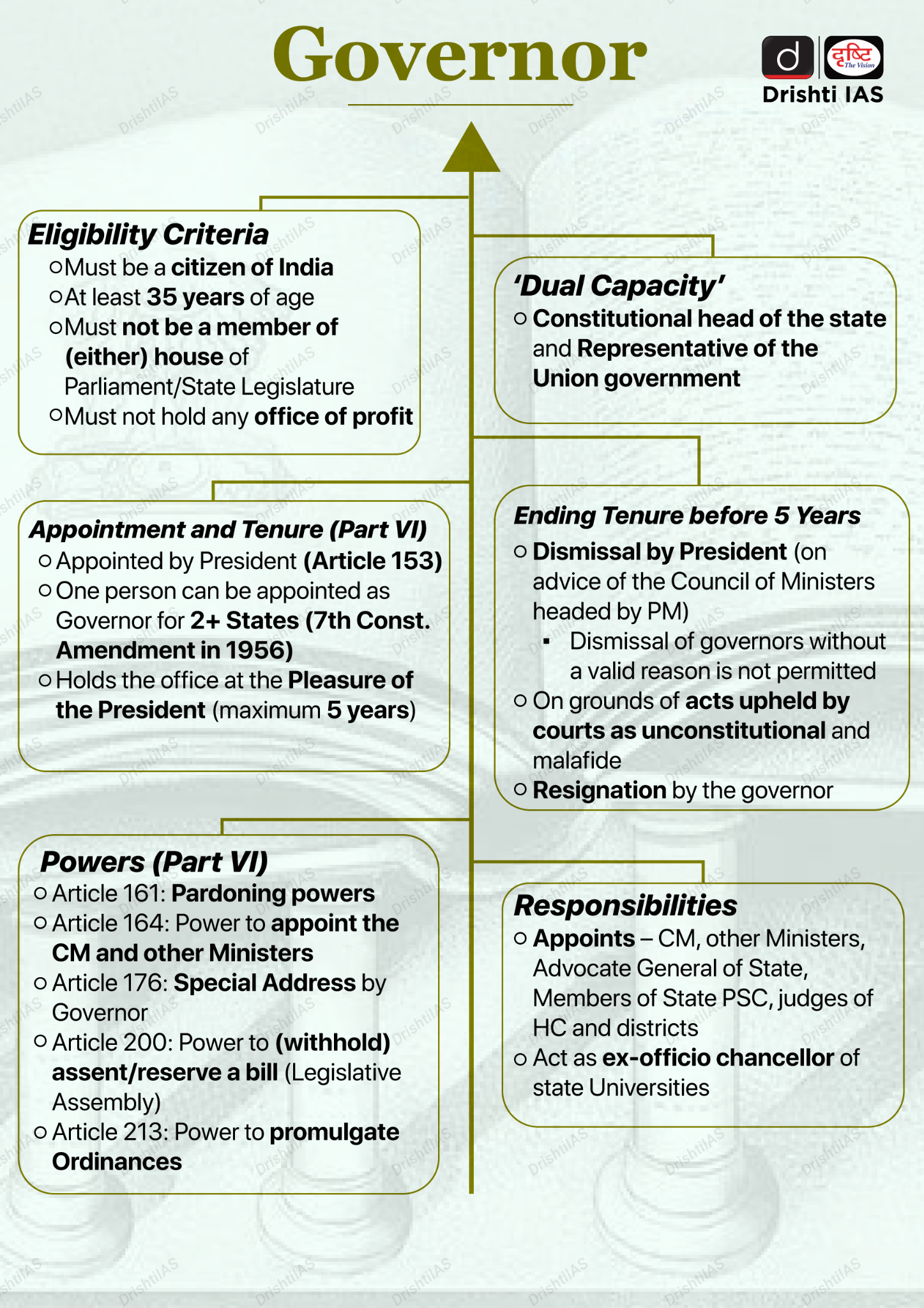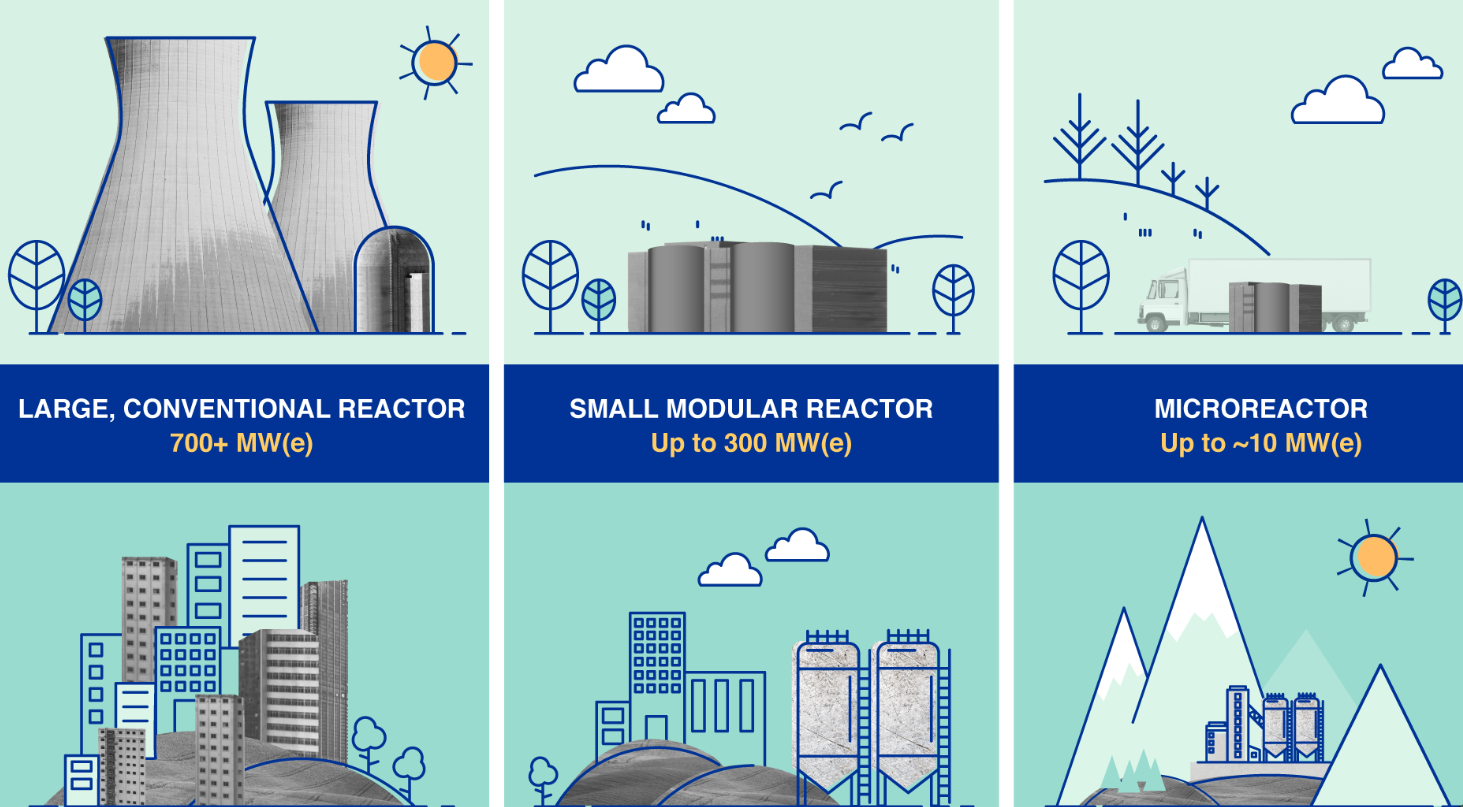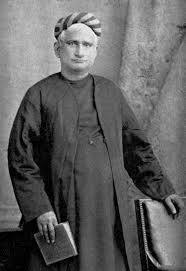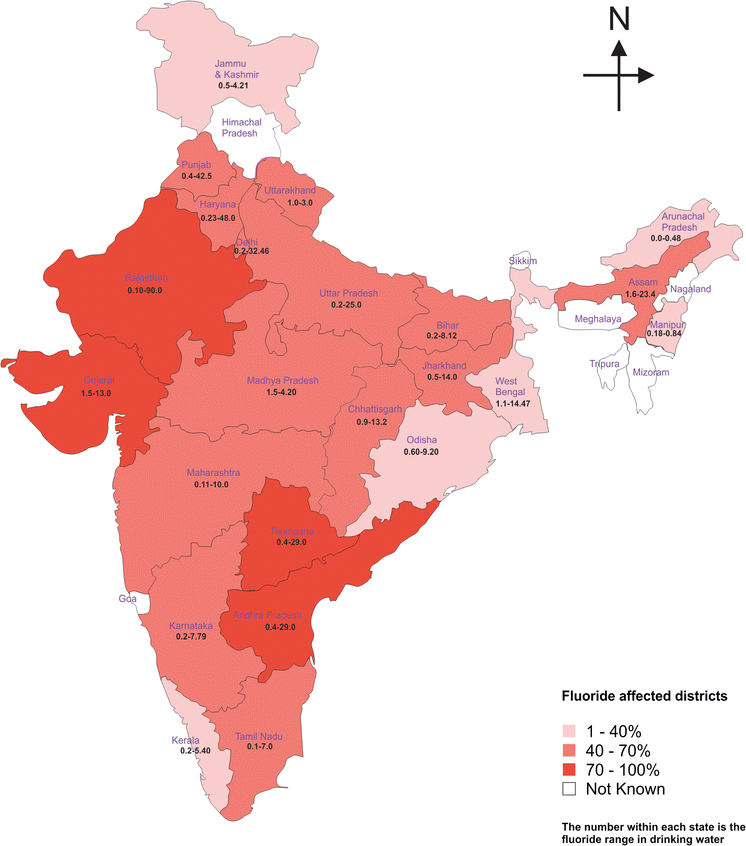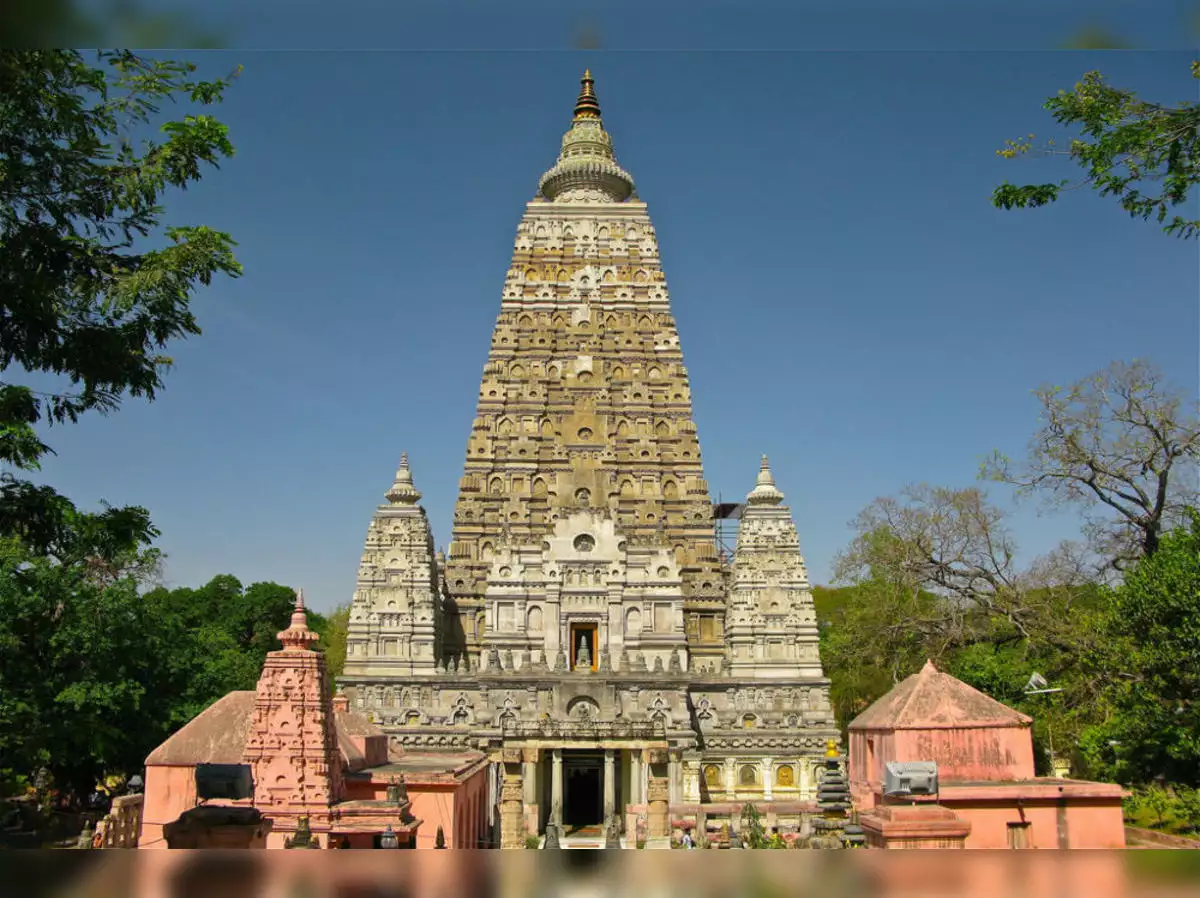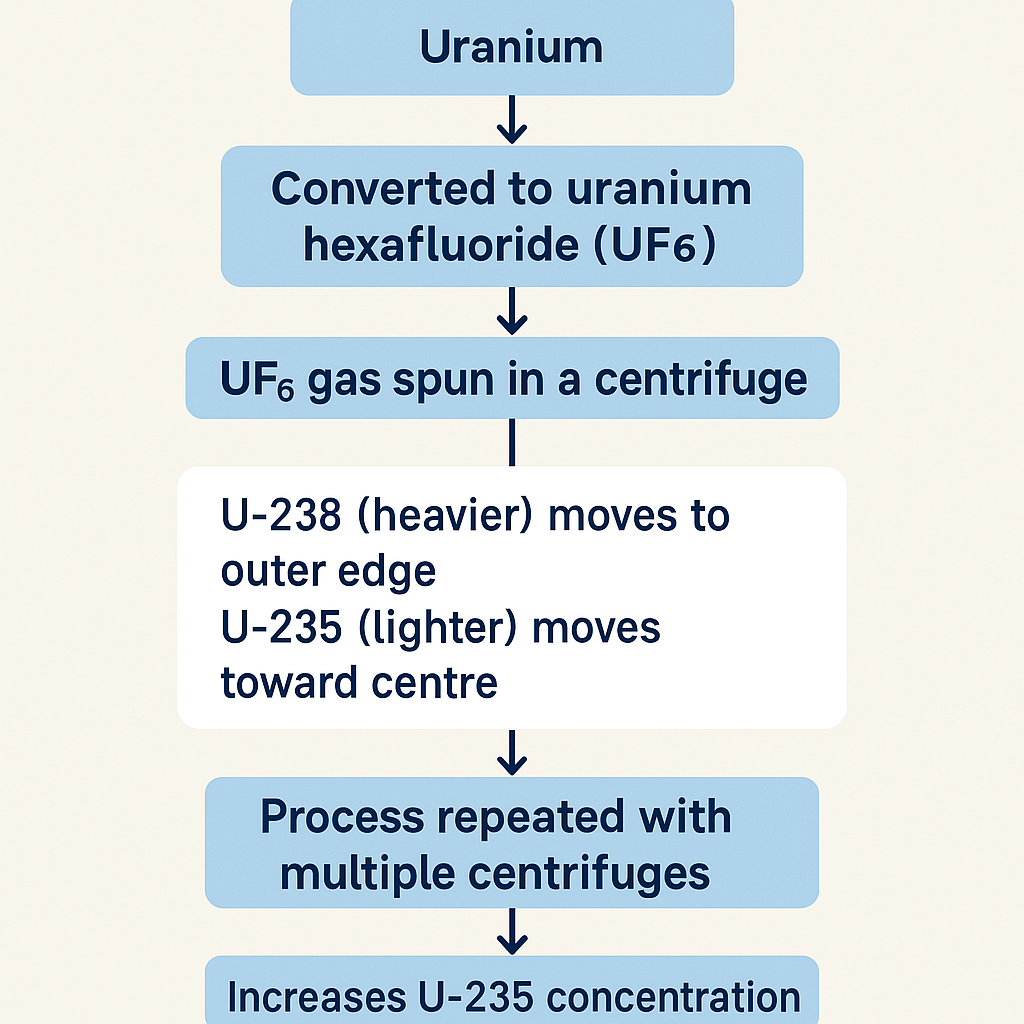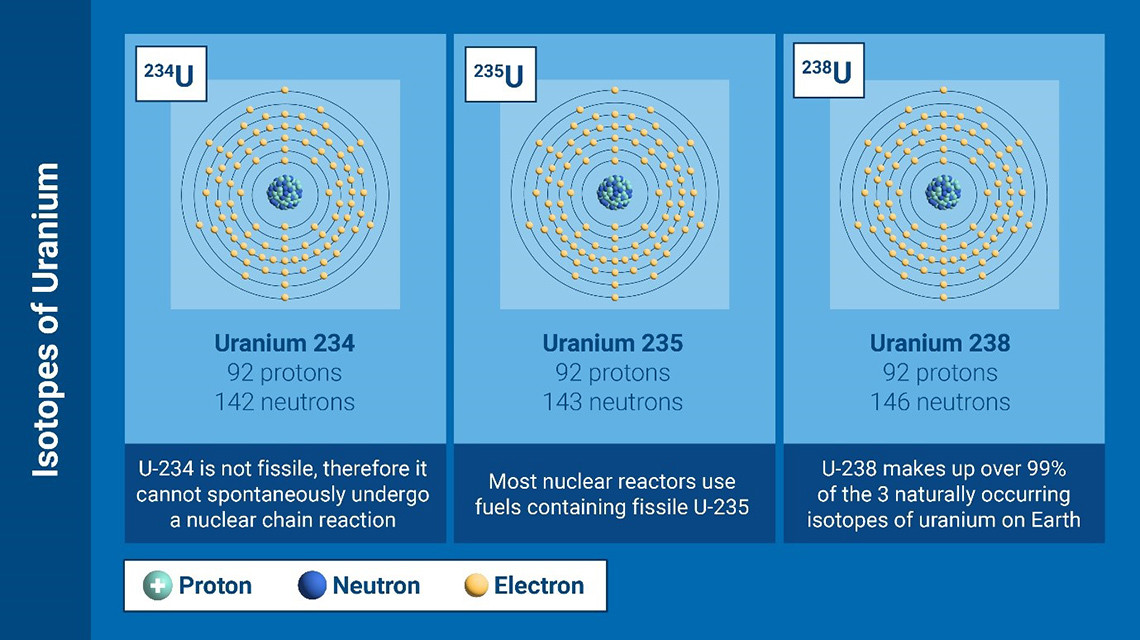Indian Polity
SC Verdict on Governors' Powers over State Bills
For Prelims: Supreme Court of India, Governor, Article 200, President, President's Rule
For Mains: Role of Governors in Indian Federalism, Judicial Review of Governor’s Actions, Balance of Power
Why in News?
The Supreme Court (SC) of India, in the State of Tamil Nadu vs. Governor of Tamil Nadu, clarified that Governors must act on state bills in a time-bound manner, following the aid and advice of the council of ministers, as per Article 200, without independent discretion.
What is the SC’s Verdict on Governors’ Role in State Bills?
- Case Background: The Tamil Nadu Governor withheld assent to 10 Bills, delaying action under Article 200. The state government challenged this, citing constitutional violations and governance disruption.
- After the Governor withheld assent, the Tamil Nadu Legislative Assembly re-enacted the Bills and sent them back. Instead of granting assent or returning them with comments, the Governor referred them to the President.
- SC’s Verdict: SC termed the Tamil Nadu Governor’s referral of re-enacted Bills to the President as “erroneous in law.”
- The Court ruled that there is no concept of "absolute veto" or "pocket veto" under Article 200 and stated that governors cannot indefinitely delay action on bills.
- SC noted that Governors are bound to follow the advice of the Council of Ministers.
- SC ruled that Governor must give assent to a bill when a bill is presented to him after re consultation in state assembly and he can only refuse assent when the bill is different.
- The SC prescribed clear timelines for Governors when dealing with Bills with one month to withhold assent, three months if doing against State Cabinet advice, and one month for Bills re-presented after reconsideration.
- The Court ruled that there is no concept of "absolute veto" or "pocket veto" under Article 200 and stated that governors cannot indefinitely delay action on bills.
- Implications: The Supreme Court ruling curbs the misuse of gubernatorial discretion to stall state legislatures, reaffirming that Governors are constitutional heads, not political actors.
- It emphasizes the primacy of the legislative process and limits executive overreach.
- The judgment sets a precedent for similar cases in states like Kerala, West Bengal, Telangana, and Punjab, where Governors have delayed assent to Bills.
What are the Constitutional Powers of a Governor with Respect To Bills?
- Article 200: The Governor has significant powers when dealing with Bills passed by the State Legislature. Upon receiving a Bill, the Governor can take one of the following actions:
- Grant Assent: The Governor may approve the Bill, allowing it to become law.
- Withhold Assent: The Governor has the authority to refuse assent to the Bill.
- Return for Reconsideration: The Governor may send the Bill back to the State Legislature for further review and reconsideration.
- Reserve for the President’s Consideration: In certain cases, the Governor can reserve the Bill for the President’s approval, especially if the Bill concerns matters of national importance or conflicts with central laws.
- Article 201: If the Governor reserves a Bill for the President's consideration, the President holds the final say on the matter. The President has the option to:
- Grant Assent: The President can approve the Bill, making it law.
- Withhold Assent: The President may choose to withhold assent to the Bill.
- For non-Money Bills, if the President withholds assent, the President can direct the Governor to send the Bill back to the Legislature for reconsideration.
- The Legislature is required to act within six months. If the Bill is passed again, it must be resubmitted to the President for final approval.
- Article 207: No Money Bill can be introduced in the assembly without the recommendation of the Governor of the State.
Note: The SC in Rameshwar Prasad case (2006) ruled that the Governor’s powers to withhold assent can be reviewed if exercised arbitrarily.
What are the Key Concerns Related to Governors in India?
- Impartiality Concerns: Governors are sometimes seen as acting as agents of the Centre's ruling party, raising concerns about their impartiality and fairness in exercising powers.
- For instance, in 2016, the Governor's actions in Arunachal Pradesh led to the dismissal of the elected government, a move later overturned by the Supreme Court, which reinstated the government.
- Questionable Use of Article 356: Governors have sometimes recommended President's Rule without a floor test, perceived as politically motivated.
- For example, in Uttarakhand (2016), the Governor recommended President's Rule just before a floor test, indicating potential political motivations.
- Overreach in State Matters: Governors have increasingly overreached in administrative matters, bypassing elected state governments and causing governance paralysis.
- In Delhi (2023), clashes between the Lieutenant Governor and the state government over bureaucratic appointments led the Supreme Court to rule that the elected government controls services.
- Governors, as Chancellors of state universities, also interfere in Vice-Chancellor appointments, often leading to legal battles, as seen in West Bengal (2023), where the Governor's unilateral appointments sparked a standoff with the state government.
- Lack of Accountability: Governors are only accountable to the President and can be removed at the Union government's discretion.
- With no impeachment provisions, they can act without facing direct consequences, undermining accountability despite holding significant powers.
What are the Key Committees and their Recommendations Related to the Governor?
|
Committee |
Recommendation |
|
Sarkaria Commission (1988) |
|
|
Punchhi Commission (2010) |
|
|
Venkatachaliah Commission (2002) |
|
What Measures can be Adopted to Address Governor-State Disputes?
- Impeachment Process for Governors: Currently, Governors can only be removed by the President, leading to a lack of state-level accountability.
- The Punchhi Commission proposed an impeachment process at the state level to enhance accountability.
- The Supreme Court’s ruling in BP Singhal vs Union of India (2010) emphasized that any removal must be for a valid reason, ensuring fairness.
- Amendment to Article 163: It grants Governors discretionary powers, which can lead to political bias.
- An amendment to Article 163 could limit these powers, clarifying they should only be used in exceptional circumstances impacting national interest or constitutional integrity.
- Review of Gubernatorial Conduct: A periodic review mechanism by Judicial Commissions could be set up to periodically assess how Governors exercise their powers.
- This would ensure that their actions align with constitutional norms, limit interference with state governance, and increase transparency.
- Clear Guidelines on Imposing President’s Rule: To prevent misuse, the Governor’s discretion in recommending President’s Rule must be exercised judiciously, backed by objective material, and remain open to judicial scrutiny, as upheld in the S.R. Bommai case (1994).
- The Sarkaria Commission further advised that it should be a last-resort mechanism, invoked only after all constitutional remedies are exhausted.
|
Drishti Mains Question: Analyze the challenges posed by the Governor’s office and propose reforms to ensure impartiality and greater accountability. |
UPSC Civil Services Examination Previous Year’s Question (PYQs)
Prelims
Q. Which of the following are the discretionary powers given to the Governor of a State? (2014)
- Sending a report to the President of India for imposing the President’s rule
- Appointing the Ministers
- Reserving certain bills passed by the State Legislature for consideration of the President of India
- Making the rules to conduct the business of the State Government
Select the correct answer using the code given below:
(a) 1 and 2 only
(b) 1 and 3 only
(c) 2, 3 and 4 only
(d) 1, 2, 3 and 4
Ans: (b)
Exp;
- Article 163 of the Constitution says that the Governor shall exercise his functions with the aid and advice of the Council of Ministers except for functions which require his discretion.
- Under Article 356 of the Indian Constitution, the Governor of a State can send a report to the President of India recommending imposition of President Rule in the State. This is a discretionary power being conferred upon the Governor. Hence, 1 is correct.
- He appoints the Chief Minister (CM) and other ministers. They also hold office during his pleasure. The appointment of ministers in the State cabinet is not at the discretion of the Governor. He only formally approves the appointment. The discretion comes under CM. Hence, 2 is not correct.
- Governor can reserve certain bills passed by the State legislature for the consideration of the President. In one case such reservation is obligatory, that is, where the bill passed by the State legislature endangers the position of the State High Court. In addition, the
- The governor can also reserve the bill if it is against the provisions of the Constitution, opposed to the Directive Principles of State Policy, against the larger interest of the country, of grave national importance, etc. Hence, 3 is correct.
- He makes rules for the more convenient transaction of the business of a state government and for the allocation among the ministers of the said business. But this power is not under the Governor’s discretion. He acts on the advice of the Council of Ministers. Hence, 4 is not correct.
- Therefore, option (b) is the correct answer
Mains
Q. Whether the Supreme Court Judgment (July 2018) can settle the political tussle between the Lt.Governor and elected government of Delhi? Examine. (2018)
Q. Discuss the essential conditions for exercise of the legislative powers by the Governor. Discuss the legality of re-promulgation of ordinances by the Governor without placing them before the Legislature. (2022)

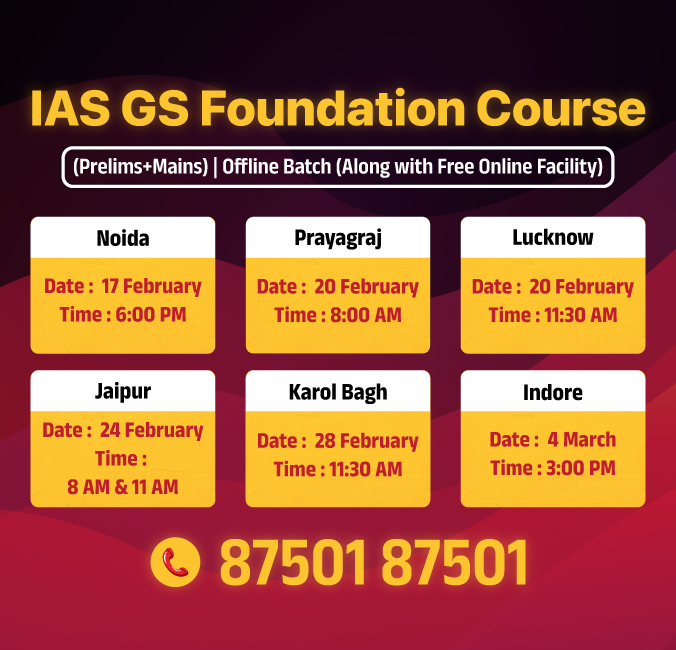
Social Issues
Challenges to Transgenders in India
For Prelims: Transgender Persons (Protection of Rights) Act, 2019, NALSA Judgement 2014, Transgender Persons (Protection of Rights) Rules, 2020, Garima Greh.
For Mains: Indian Society and the Challenges faced by Transgenders, Reforms for Transgender Persons, Transgender Persons (Protection of Rights) Act - Provisions and Associated Concerns
Why in News?
31st March is observed as International Transgender Day of Visibility to raise awareness about the discrimination, and violence faced by transgender individuals.
- Despite the enactment of the Transgender Persons (Protection of Rights) Act, 2019, the community continues to face challenges, highlighting the gap between legal provisions and ground realities.
Who is a Transgender?
- About: According to Transgender Persons (Protection of Rights) Act, 2019, a transgender person is someone whose gender identity does not align with the gender assigned at birth.
- Population: According to the Census 2011, they have a population of around 4.8 million. It includes trans-person with intersex variations, gender-queer and people having such socio-cultural identities as kinnar, hijra, aaravani and jogta.
- Part of LGBTQIA+: Transgender individuals are part of the LGBTQIA+ community, represented by the "T" in the acronym.
- LGBTQIA+ is an acronym that represents lesbian, gay, bisexual, transgender, queer, intersex, and asexual.
- The "+" represents the many other identities that are still being explored and understood.
- The acronym is constantly evolving and may include other terms like non-binary and pansexual.
What are the Challenges Faced by Transgenders in India?
- Implementation Gaps: Despite the 2019 Act mandating timely support for transgender persons, only 65% of ID card applications had been processed by December 2023, with over 3,200 applications delayed beyond the 30-day legal deadline.
- The complex certification process hinders self-identification and fails to address issues like police harassment and family rejection.
- Social Discrimination: Transgender individuals in India face widespread rejection, bullying, and discrimination, leading to poor mental health- 31% die by suicide, and 50% attempt it before age 20.
- A NALSA survey found 27% were denied care due to gender identity. Gender-affirming treatments cost Rs 2–5 lakh, often uncovered by insurance.
- Despite Ayushman Bharat TG Plus offering Rs 5 lakh annual coverage, awareness and accessibility are limited.
- Economic Exclusion: People face restricted employment and entrepreneurship opportunities due to hiring biases, workplace hostility, and lack of gender-neutral facilities.
- 92% face economic exclusion (NHRC 2018), with a 48% unemployment rate (ILO 2022). Despite a 2024 circular on joint bank accounts, financial access remains limited due to poor awareness and institutional gaps.
- Barriers in Education: Transgenders in India have a literacy rate of 56.1%, below the national average (74%) (2011 Census). While states like Maharashtra and Kerala have introduced inclusive measures, a nationwide gender-sensitive curriculum is lacking.
What is Transgender Persons (Protection of Rights) Act, 2019?
- About: The Act aims to protect the rights of transgender persons and provide a legal framework for their empowerment.
- Key Provisions:
- Non-Discrimination: Prohibits discrimination in education, employment, healthcare, and public services.
- Self-Identification: Grants the right to self-perceived gender identity, with certificates issued by district magistrates without medical exams.
- Medical Care: Ensures access to gender-affirming treatments and HIV surveillance with insurance coverage.
- National Council: Under this act National Council for Transgender Persons (NCTP) was established as a statutory body in 2020.
Key Milestones in Transgender Rights Reforms
- Election Commission's Directive (2009): The registration forms were updated to include an "others" option, enabling transgender individuals to avoid male or female identification.
- Supreme Court Ruling (2014): In the National Legal Services Authority vs. Union of India case, 2014, the Supreme Court recognized transgender people as the "Third Gender," framing it as a human rights issue.
- Legislative Efforts (2019): The Transgender Persons (Protection of Rights) Act, 2019 was enacted to safeguard the rights of transgender individuals.
What is India's Effort for Transgender Welfare?
- SMILE scheme
- Garima Greh
- Ayushman Bharat TG Plus
- National Portal for Transgender Persons
- Transgender Pension Scheme: Transgender individuals are now eligible for the disability pension scheme, with the inclusion of a "transgender" option in the disability form.
- Recognition in Indian Prisons: In January 2022, the Ministry of Home Affairs sent an advisory to Heads of Prisons in the States/UTs to ensure privacy, dignity of the third gender inmates.
- State-Level Efforts: Maharashtra has established transgender cells in colleges, while Kerala provides university-level reservations and hostel facilities for transgender persons.
Way Forward
- Strengthening Legal Framework: Transgender Persons (Protection of Rights) Act, 2019 needs to be implemented in letter and spirit to ensure timely welfare access.
- Economic Empowerment: Gender-inclusive policies, diversity hiring, and financial schemes are vital. Scaling models like Tata Steel’s can boost participation.
- A 2021 World Bank report estimates a 1.7% GDP rise if transgender individuals are integrated into the workforce.
- Healthcare Access: Insurance should cover gender-affirming treatments, and providers must receive sensitivity training. Dedicated transgender clinics and expanded mental health services are essential.
- Promoting Social Awareness: Promote gender sensitisation in educational institutions and workplaces, diverse media representation, and cultural events like the Koovagam Festival.
- Awareness campaigns such as "I Am Also Human" are essential in challenging societal prejudices.
- International Best Practices: India can enhance transgender rights by adopting self-declaration of gender identity, gender-neutral policies, and anti-discrimination laws, inspired by countries like Argentina, Canada, and the UK.
|
Drishti Mains Question: Discuss the challenges faced by transgender persons in India despite legal advancements. What measures are needed for their inclusion? |
UPSC Civil Services Examination, Previous Year Questions (PYQs)
Prelims
Q. In India, Legal Services Authorities provide free legal services to which of the following type of citizens? (2020)
- Person with an annual income of less than Rs. 1,00,000
- Transgender with an annual income of less than Rs. 2,00,000
- Member of Other Backward Classes (OBC) with an annual income of less than Rs. 3,00,000
- All Senior Citizens
Select the correct answer using the code given below:
(a) 1 and 2 only
(b) 3 and 4 only
(c) 2 and 3 only
(d) 1 and 4 only
Ans: (a)

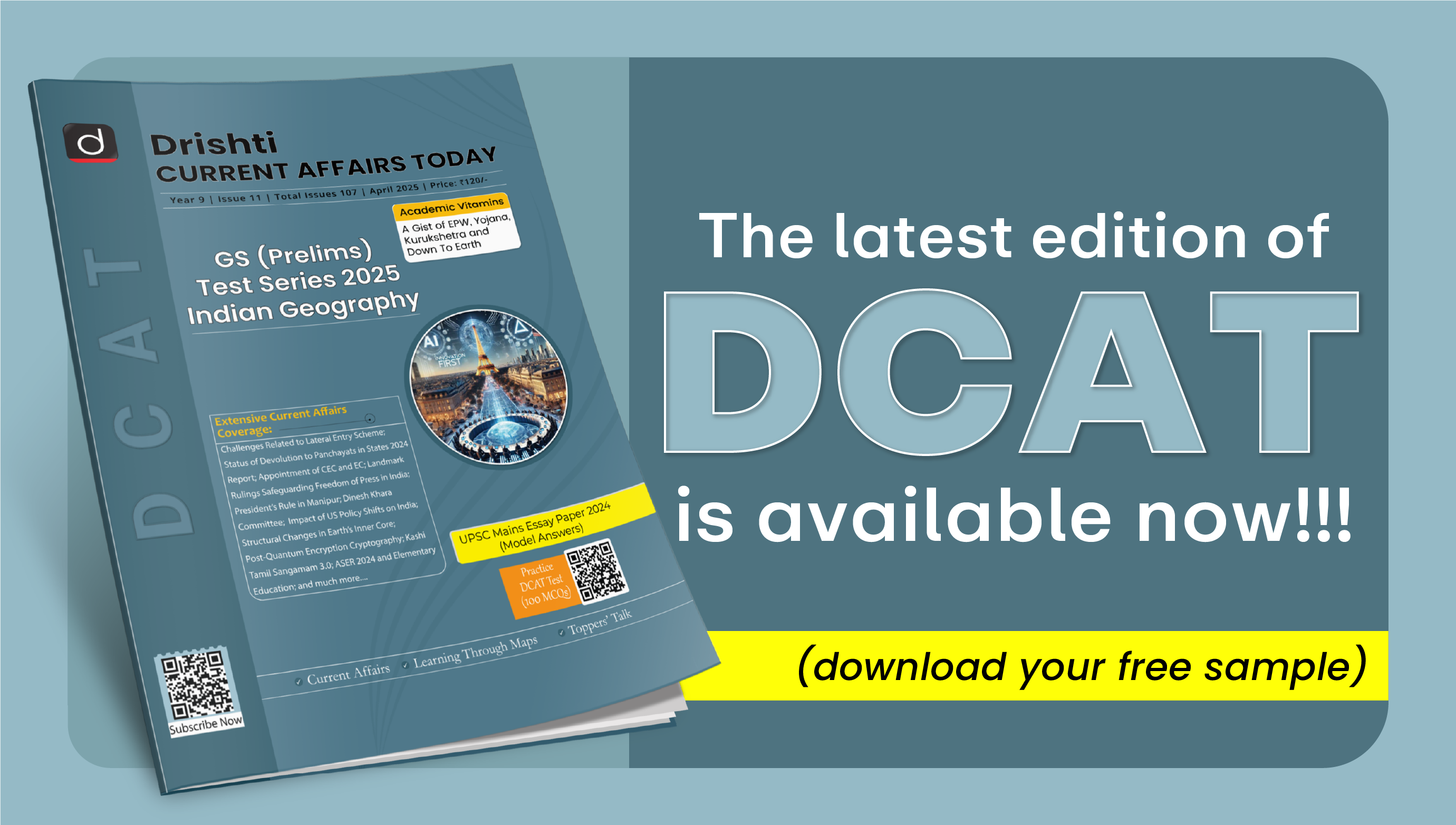
Science & Technology
US to Build Small Modular Reactors in India
For Prelims: Small Modular Reactor (SMR) technology, International Atomic Energy Agency, 2008 India-US Civil Nuclear Deal or 123 Agreement, Civil Liability for Nuclear Damage Act, 2010, Atomic Energy Act, 1962, Union Budget 2025–26.
For Mains: SMR and India, Advancements of Indian in Nuclear Technology
Why in News?
The US has granted approval to Holtec International under its regulation 10CFR810, to transfer unclassified Small Modular Reactor (SMR) technology to 3 Indian private entities.
What are the Key Highlights of India-US SMR Technology Nuclear Deal?
- Validity:
- The authorization, valid for 10 years and subject to review every 5 years, allows Holtec to design and construct nuclear reactors in India.
- Regulatory Safeguards:
- Under the approval, SMR technology can only be used for peaceful civilian purposes, must follow International Atomic Energy Agency (IAEA) safeguards, and cannot be used for military activities, ensuring compliance with global non-proliferation norms.
- Significance:
- Operationalises the 123 Agreement: Revives the 2008 India-US Civil Nuclear Deal or 123 Agreement by overcoming legal and commercial barriers.
- Encouraging Private Sector: Marks the first direct US tech transfer to Indian private firms, shifting from state-only control to a public-private (PPP) model.
- Boosting Indigenous Capability: Facilitates local manufacturing of SMR and positions India as a future hub for nuclear innovation and exports, especially for the Global South.
- Legal and Policy Challenges:
- Civil Liability for Nuclear Damage Act, 2010: Civil Liability for Nuclear Damage Act, 2010 holds suppliers liable for nuclear accidents, discouraging foreign investment and tech transfer.
- Atomic Energy Act, 1962: Atomic Energy Act, 1962 restricts nuclear power generation to government entities, barring private firms from owning or operating plants.
- The government has formed inter-ministerial committees to amend the Atomic Energy Act, 1962 and the Civil Liability for Nuclear Damage Act, 2010, aiming to enable private sector participation in nuclear energy.
What are Small Modular Reactors (SMRs)?
- About:
- SMRs are advanced nuclear reactors with a capacity of up to 300 MW(e), about one-third of traditional reactors.
- They are compact, factory-assembled, and transported for installation, making them suitable for remote or space-constrained areas.
- Eg: NuScale (USA), CAREM (Argentina)
- Key Features:
- SMRs are compact nuclear reactors that generate low-carbon electricity. They are:
- Small: Much smaller in size compared to conventional nuclear reactors.
- Modular: Factory-built components can be transported and assembled on-site.
- Reactors: Use nuclear fission to produce heat, which is converted into energy.
- SMRs are compact nuclear reactors that generate low-carbon electricity. They are:
- Key Advantages:
- Fuel Efficiency: Require refueling every 3-7 years (as compared to 1–2 years in conventional plants).
- Scalability & Flexibility: Easily integrated into diverse power systems and can be scaled for remote areas or urban grids.
- Reduce reliance on rare reactor-grade fuels or advanced enrichment processes.
- Passive Safety: Incorporate inherent safety systems for enhanced accident resilience.
- Low-Carbon & Reliable: Provide 24/7 clean energy, complementing renewables and aiding grid stability, helping meet rising energy demand and net-zero goals by 2070).
- SMR and India:
- Budgetary Allocation: The Union Budget 2025–26 announces the launch of a Nuclear Energy Mission with focus on research and development of Small Modular Reactors (SMRs) and develop at least 5 indigenously designed and operational SMRs by 2033.
- Bharat Small Reactors (BSRs): BSR are 220 MW Pressurized Heavy Water Reactors (PHWRs) with a strong safety record which will be deployed near industries like steel, aluminium, and metals, functioning as captive power plants to aid decarbonization.
- Private entities will provide land, cooling water, and capital, while NPCIL will handle design, quality assurance, and operations.
- This initiative aligns with India's COP26 pledge to achieve 500 GW of non-fossil fuel-based energy and 50% renewable energy by 2030.
- Private entities will provide land, cooling water, and capital, while NPCIL will handle design, quality assurance, and operations.
- Small Modular Reactors (SMRs): Bhabha Atomic Research Centre (BARC) is working on SMRs for repurposing retiring coal-based power plants and meeting the energy needs of remote areas.
- The Department of Atomic Energy (DAE) is also focusing on developing reactors such as high-temperature gas-cooled reactors for hydrogen generation and molten salt reactors to utilize India’s vast thorium resources.
UPSC Civil Services Examination, Previous Year Questions (PYQs)
Prelims
Q. The function of heavy water in a nuclear reactor is to (2011)
(a) Slow down the speed of neutrons
(b) Increase the speed of neutrons
(c) Cool down the reactor
(d) Stop the nuclear reaction
Ans: (a)


Indian Economy
Urban Transport in India
For Prelims: Smart Cities Mission, Transit-Oriented Development, Particulate Matter, Urban Local Bodies
For Mains: Urban transport reforms and inclusive mobility, Role of public policy in sustainable urban mobility, Affordability vs. accessibility in public transportation
Why in News?
Bengaluru’s Namma Metro has become the costliest metro service in India after a steep fare hike in February 2025. The move has raised concerns over the urban transport affordability. Without fair pricing, public transport risks losing commuter trust.
What are the Concerns Regarding Urban Transport Systems?
- Affordability: Rising fares in metro (Bengaluru’s Rs 90 fare for more than 30 km) and bus services are making daily commuting increasingly expensive for low- and middle-income groups.
- Additionally, surge pricing by mobility apps during peak hours or bad weather makes travel costly, undermining the National Urban Transport Policy (NUTP) 2006 and Smart Cities Mission that emphasize affordable and accessible mobility for all.
- Weak Non-Motorised Transport (NMT) Infrastructure: Most Indian cities lack safe and accessible infrastructure for NMT like pedestrian zones (pedestrian fatalities >40% in Delhi, Kolkata, Bengaluru) and cycling tracks.
- Where such paths exist, they are often encroached, poorly designed, or badly maintained, making them unsafe and unusable.
- Land use and transport planning are poorly integrated, with weak Transit-Oriented Development (TOD) implementation.
- Congestion: Indian cities face severe traffic congestion, private vehicles, despite serving under 20% of commuters, occupy 90% of road space. This mismatch, along with stagnant road infrastructure, leads to long commutes and reduced productivity.
- Environmental Impact: In 2020, India’s transport sector accounted for 14% of total energy-related CO₂ emissions. Vehicles remain the largest source of Particulate Matter (PM2. 5) and NOx emissions in cities like Delhi, causing severe health issues and environmental damage, thereby undermining efforts to achieve India’s Net Zero target by 2070.
- Lack of clean fuel policies and slow adoption of electric mobility worsen the crisis.
- Inadequate Public Transport Systems: Only 63 of 458 cities with population >1 lakh have a formal bus service. India has just 1.2 buses per 1,000 people compared to global benchmarks of 5-8 (NITI Aayog, 2018).
- Most cities lack well-connected transit networks, with metro services missing peri-urban areas, while unregulated informal modes like auto- and e-rickshaws raise security concerns.
- Financial and Capacity Constraints: Urban Local Bodies (ULBs) lack financial autonomy and rely heavily on state or central funding.
- Their limited ability to raise resources through tools like land value capture, congestion pricing, or green bonds hinders affordable and sustainable transport projects.
What Can Be Done for Sustainable and Inclusive Urban Mobility?
- Investment in NMT: Nearly 50% of urban trips in Indian cities are under 5 km, according to the Ministry of Housing and Urban Affairs, making them ideal for NMT.
- Dedicated lanes and safe infrastructure for walking and cycling can promote affordable and sustainable urban mobility.
- Adopt Best Practices: Cities like Kochi (Most Sustainable Transport System), Bhubaneswar (Best Public Transport), and Srinagar (Best Non-Motorized Transport) showcase replicable models. Recognizing and scaling these practices will accelerate transformation.
- Affordable Public Transport Access: Promote subsidized fare structures (e.g., monthly passes) and leverage non-fare revenue sources (such as advertisements and retail leasing at stations) to reduce the financial burden on commuters.
- Clean Transport: Promote clean mobility through FAME II, PM e-Bus Sewa, and provide subsidies or tax cuts on EVs to accelerate the adoption of electric buses and green commuting.
- Empower ULBs: Enable ULBs to leverage land value capture, congestion pricing, green bonds, and parking charges under MoHUA’s Value Capture Finance (VCF) Policy 2017 to address financing challenges and support sustainable mobility services.
- Integrated Public Transport Systems: Fund integrated public transport systems focused on moving people, not vehicles. Encourage multimodal transport, seamless ticketing, real-time tracking, and TOD under Transit Oriented Development Policy, 2017 to reduce private vehicle use.
- Strengthen Unified Metropolitan Transport Authorities (UMTAs) for coordinated mobility planning aligned with Smart Cities and AMRUT goals.
What is Transit-Oriented Development?Click here to Read: Transit-Oriented Development |
What are the Initiatives Related to Urban Mobility in India?
|
Drishti Mains Question: Urban transport in India faces multidimensional challenges, suggest a comprehensive strategy for making it sustainable and inclusive. |
UPSC Civil Services Examination, Previous Year Question (PYQ)
Mains
Q. The Gati-Shakti Yojana needs meticulous coordination between the government and the private sector to achieve the goal of connectivity. Discuss. (2022)


Rapid Fire
Bankim Chandra Chattopadhyay
The death anniversary of Bankim Chandra Chattopadhyay was observed on 8th April, remembering his contributions to Indian literature, nationalism, and the cultural awakening of Bengal during the 19th century.
- Early Life: Born on 27th June 1838 in Naihati, West Bengal, Bankim was a brilliant student and joined British service after completing his studies.
- Nationalism and Literature: Through works like Anandamath (banned by the British), which narrates the Sanyasi Rebellion, Bankim became synonymous with India's struggle for independence.
- The national song of India, Vande Mataram, originated from Bankim’s Anandamath, becoming a symbol of the freedom movement.
- Famous Works: Rajmohan’s Wife ((1864) (first novel in English by an Indian). His novels Durgeshnandini (1865), Kapalkundala (1866), and Vishabriksha (1873) addressed social issues like women's rights, child marriage, and caste discrimination.
- Also, his notable religious writings include Krishna Charitra.
- Role in the Bengali Renaissance: Bankim started the literary magazine Bangadarshan (1872), which played a key role in fostering Bengali nationalism.
- Bankim’s vision for Bangadarshan was to bridge the gap between the educated and uneducated classes and promote Bengali identity.
- Rabindranath Tagore, deeply influenced by Bangadarshan, later revived the magazine, making it a platform for nationalist writings.
- Bankim’s vision for Bangadarshan was to bridge the gap between the educated and uneducated classes and promote Bengali identity.
| Read more: Bankim Chandra Chattopadhyay |
Rapid Fire
Limits on Validity of Foreign Funds
The Ministry of Home Affairs (MHA) has revised its policy on foreign funds obtained through the prior permission route, limiting the validity to four years, unlike the earlier policy where the funds could be utilized until the entire amount was spent.
- New Order: Specifies that the validity for receiving foreign contributions will be three years from the approval date, and the utilization window will be four years.
- For applications already approved, the four-year limit will apply from the date of the new MHA order, even if the approved project timeline exceeds three years.
- Impact of Time Limit: Non-compliance with the time limit will result in a violation of the Foreign Contribution (Regulation) Act, 2010 (FCRA), attracting punitive actions.
- FCRA Prior Permission: Under the FCRA, entities (Non-Governmental Organisations (NGOs)) that are not registered with the Central Government must obtain prior permission to accept foreign contributions. This permission is specific to the purpose and the source of the funds.
- Entities must be registered under statutes like the Societies Registration Act, 1860, Indian Trusts Act, 1882, or the Companies Act, 2013.
- A bank account with State Bank of India, New Delhi, is mandatory for FCRA transactions.
- Additionally, the Chief Functionary of the recipient Indian organization should not be part of the donor organization, and 75% of governing body members should not be connected to the foreign donor or its family.
- Entities must be registered under statutes like the Societies Registration Act, 1860, Indian Trusts Act, 1882, or the Companies Act, 2013.
| Read more: Foreign Contribution Regulation Act |


Rapid Fire
Fluoride Contamination
Excess Fluoride in Sonbhadra's groundwater (Uttar Pradesh), has triggered a growing public health crisis.
- Fluoride: It is a highly reactive element that does not occur in elemental form in nature.
- It makes up 0.3 g/kg of the Earth’s crust and is found as fluoride (oxidation state -1) in minerals like fluorspar, cryolite, and fluorapatite.
- Major Uses: Widely used in aluminium production, and as fluxes in steel and glass fibre industries. They are also released during the manufacture of phosphate fertilizers, bricks, tiles, and ceramics.
- Compounds like fluorosilicic acid, sodium hexafluorosilicate, and sodium fluoride are used in municipal water fluoridation.
- Health Impacts: Fluoride has a dual impact, it is beneficial in small amounts (prevents dental caries), but harmful in excess (causes dental fluorosis (mottling of teeth enamel, mainly in children) and skeletal fluorosis (bone/joint issues) ).
- As per the Bureau of Indian Standards, the safe fluoride level in water is 1 to 1.5 mg/L (milligrams per liter), levels above this are considered hazardous to health.
- Schemes for Fluoride Control in India: India launched the National Programme for Prevention and Control of Fluorosis (NPPCF) during the 11th Five Year Plan. Additionally, the Jal Jeevan Mission aims to ensure safe drinking water.
| Read more: Fluoride & Iron Removal technology of CMERI |


Rapid Fire
Mahabodhi Temple
Buddhist monks under the All India Buddhist Forum (AIBF) have launched protests at Bodh Gaya’s Mahabodhi Temple (Mahavihara) demanding the repeal of the Bodh Gaya Temple Act (BTA), 1949.
- Provisions of the Act under Spotlight:
- The BTA created an eight-member management committee with equal representation from Hindus and Buddhists.
- It appointed the district magistrate as the ex-officio chairperson.
- Since the district magistrate has traditionally belonged to the Hindu majority, this led to a functional Hindu majority in the committee.
- Buddhist bodies have long demanded full control over the Mahabodhi Temple.
- The BTA created an eight-member management committee with equal representation from Hindus and Buddhists.
- Mahabodi Temple:
- Emperor Ashoka worshiped at the Bodhi tree and built the Mahabodhi Temple in the 3rd century BCE.
- The temple remained a Buddhist site through the Pala period and was visited by Chinese traveler Hiuen Tsang in 629 AD.
- Following Bakhtiyar Khilji’s invasion in the 13th century, Buddhism declined in the region.
- The present Temple dates to 5th–6th century CE (Late Gupta period); made entirely of brick.
- In 1590, a Hindu monk established the Bodh Gaya mutt, bringing the temple under Hindu control.
- After Independence, the BTA (1949) transferred control from the Hindu head to a shared management committee.
- Architectural Features: Shikhara,Vajrasana (Diamond Throne), Chaitya niches, amalaka, kalasha, Sculpted balustrades, Buddha images, votive stupas.
- Seven Sacred Sites include Animeshlochan Chaitya, Ratnachakrama, Lotus Pond, Ajapala Nigrodh Tree, Ratnaghar Chaitya etc., marking Buddha's 7 weeks after Enlightenment.
- Emperor Ashoka worshiped at the Bodhi tree and built the Mahabodhi Temple in the 3rd century BCE.
| Read More: Buddhism's Global Legacy |


Rapid Fire
Centrifuge Process of Uranium Enrichment
Uranium Enrichment is used to increase U-235 concentration to the desired level.
- Need for Enrichment: Natural uranium has 99.3% U-238 and 0.7% U-235. Nuclear reactors require 3–20% U-235, while nuclear weapons require about 90% U-235.
- Uranium enriched beyond 20% is considered as highly enriched.
- Centrifuge Process of Uranium Enrichment:
- In this method, uranium is first converted into a gas called uranium hexafluoride (UF₆).
- UF₆ is the only gaseous form of uranium suitable for centrifuge separation.
- Uranium has two main isotopes U-238 (heavier) and U-235 (lighter and used in nuclear reactors/weapons), having a small mass difference of 1.27%.
- When the UF₆ gas is spun at very high speeds (around 50,000 rpm) inside a centrifuge, the heavier U-238 moves to the outer edge, and the lighter U-235 stays closer to the centre.
- This process is repeated across many centrifuges, gradually increasing the U-235 concentration in the final product.
- In this method, uranium is first converted into a gas called uranium hexafluoride (UF₆).
- Centrifuge Design:
- The centrifuge has a rotor chamber made from strong, lightweight material (like carbon fibre) to withstand extreme speeds and forces without breaking.
| Read More: India’s Nuclear Programme |



